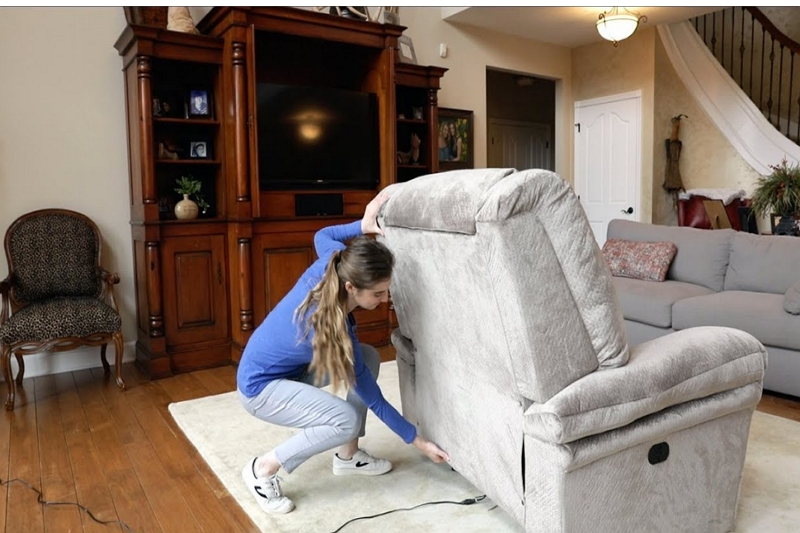Most people don’t know the guide on power recliner troubleshooting because they are an expensive purchase. However, you can save yourself the headache of trying to repair one by following these simple steps on how to troubleshoot your power recliner.

Power Recliner Troubleshooting
Step 1. Remove any objects around the recliner that could be in the way of the wires or cord.
Step 2. If there is a button for “off/on,” press it and see if this makes it work again.
Step 3. If not, check to make sure that all connections are plugged into their corresponding slots securely and tightly (don’t forget about underneath!).
Step 4. Try flipping over your recliner so that you can access both sides where cables might have come loose or the power cord might have come undone.
Step 5. If it still doesn’t work, try checking to see if your recliner has an on/off button (most do) and press that.
Step 6. Finally, make sure you’re using a surge protector with at least 500 joules of protection – these protectors will save your recliner from sudden power surges! If it still doesn’t work, contact the manufacturer for support.
How to Prevent Wear and Tear on a Recliner
Using a surge protector is the best way to protect your recliner from sudden power surges!
Make sure you’re always using an appropriate cleaning solution (never ammonia or chlorine, as they could damage the fabric), and be gentle when wiping down. It’s not enough that it just looks clean – use lint brushes often and vacuum the recliner regularly.
If you have a fabric or leather recliner, make sure there’s enough air circulation to avoid mold and mildew growth (this can be done by opening windows for periodic fresh airflow). Never leave wet clothes draped over your chair!
Lastly, if it seems like an item of clothing is always getting stuck on the recliner, it can be a sign that you need to clean your chair more often.
Some signs of wear and tear are:
- Uneven leg height (adjust as necessary)
- Damage or missing control buttons/power cord(s)
- Worn fabric or leather in areas where you sit
- Uneven arm height
- Worn fabric or leather in areas where you rest your arms.
If none of these problems are present, it may just be a loose connection on the recliner’s power cord – there should be at least one more plug to disconnect and reconnect before making this assumption (although if all plugs are in use and none of these problems persist, it may be time to call an electrician).
How to Fix Power Recliner Tension Strings
If you can’t get your recliner to stay upright and in place, it may be time to tighten or replace the tension strings. Fixing them is a fairly simple process: first, find where they are located on either side of the chair frame; then grab both ends with pliers and pull tight (or how far as they will go).
How to Fix a Power Recliner
If your recliner is not working properly, the first thing you should check is how tight all of the connections are. This includes plugging them in securely and tightly into their corresponding slots on both sides of the chair.
Next, try flipping over your recliner so that you have access to both sides where cables might come loose or come undone. Look for any small cables that might have come loose and then reconnect them to the corresponding plug-ins, making sure they are securely in place with no exposed wires or plugs.
Finally, if you still cannot find anything wrong after checking all of these connections, it’s time to contact your recliner manufacturer for help!
How to Arrange A Power Recliner in a Living Room: Ideas and Advice
#1. When arranging a power recliner in your living room, it’s important to take into account how much space you have. A big difference between the two chairs is the size of their base – some will be wider than others and consume more floor space when opened up. When considering how a chair will look in a certain area, think how it will look when opened and how much space is available.
#2. You should always consider how a chair will look when opened or closed, depending on what you want to use it for. If your living room has plenty of floor space available between furniture and walls then position the recliner with enough space between itself and other pieces of furniture.
This will allow you to open the chair and relax without kicking other items out of your way or bumping into anything when closing it again.
#3. If, however, there’s limited space in a room then consider how much floor space is available before positioning the recliner – if there isn’t enough then this may be an instance of how the recliner should be positioned against a wall.
#4. If there’s not enough floor space available then it may be better to position the chair in front of a sofa or settee – this will allow you more room during use and when closing it again. As long as there is some space left between any furniture, your walls, and the chair then this is a suitable position.
#5Also, be aware of how much space you have behind your furniture: if there’s not enough then it may mean that you’ll need to move some pieces around before placing your recliner in any room – otherwise you might end up with it blocking an exit or doorway when fully open.
